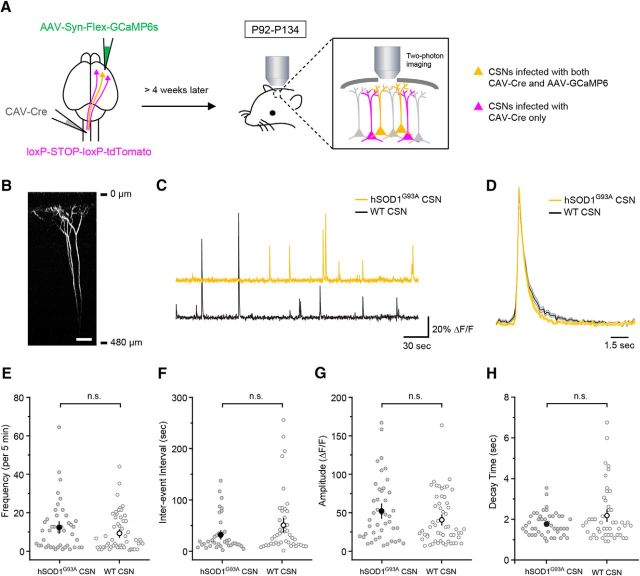Figure 3.
The activity of corticospinal neurons measured in vivo is similar in symptomatic hSOD1G93A and control mice. A, Canine adenovirus carrying a Cre recombinase construct was injected into the left spinal cord of hSOD1G93A;lox-STOP-lox-tdTomato (hSOD1G93A) or lox-STOP-lox-tdTomato (WT) mice. An adeno-associated virus (AAV) carrying a Cre-dependent GCaMP6s construct was injected into the right motor cortex. Only a subset of CSNs transfected with both viruses expressed both tdTomato and GCaMP6s. B, Morphology of an imaged CSN. Scale bar, 50 μm. C, Representative traces of calcium events recorded from CSNs in an hSOD1G93A and a WT animal. D, Averaged isolated calcium events from hSOD1G93A and WT mice. E, F, The mean frequency of events (E; hSOD1G93A: 12.4 ± 2.0 events/5 min epoch, n = 43 cells from 12 mice; control: 9.3 ± 1.3 events/5 min epoch, n = 55 cells from 14 mice; p = 0.2139, Mann–Whitney test) and the mean interevent interval (F; hSOD1G93A: 32.0 ± 5.3 s, n = 40 cells from 9 mice; WT: 50.7 ± 8.7 s, n = 46 cells from 14 mice; p = 0.1064, Mann–Whitney test). G, H, The mean amplitude (G; hSOD1G93A: 52.3 ± 6.2 ΔF/F, n = 43 cells from 12 mice; WT: 41.4 ± 4.4 ΔF/F, n = 55 cells from 14 mice; p = 0.2026, Mann–Whitney test) and the time course of the event decay (H; hSOD1G93A: 1.8 ± 0.1 s, n = 40 cells from 11 mice; WT: 2.2 ± 0.2 s, n = 49 cells from 13 mice; p = 0.5092, Mann–Whitney test).

